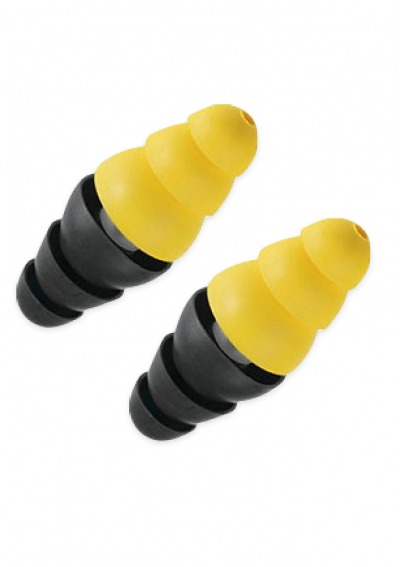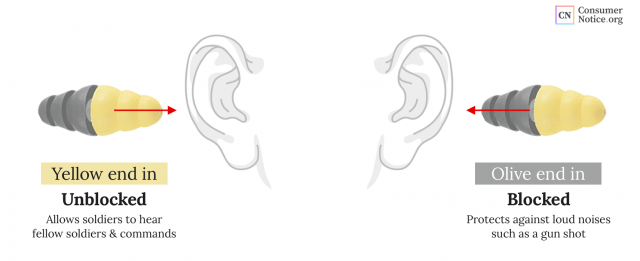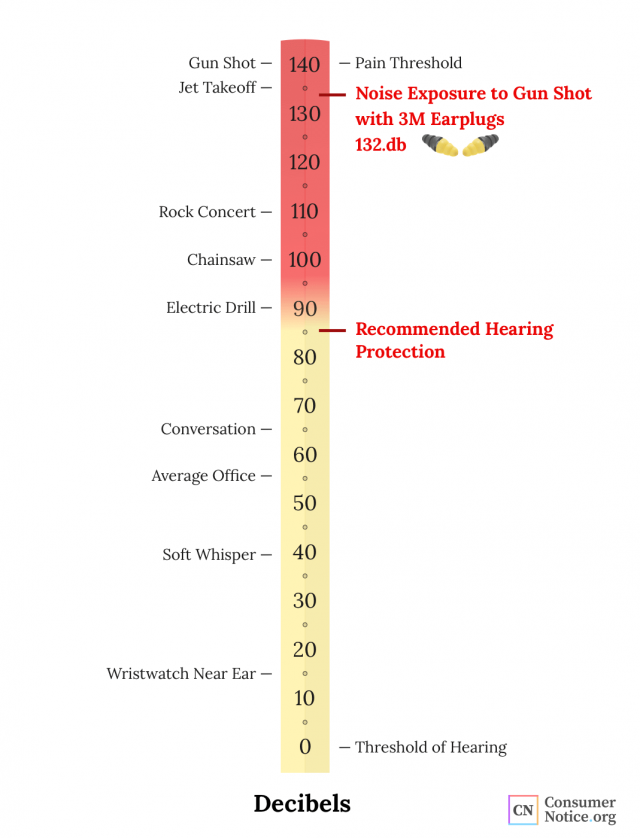3M Combat Arms Earplugs
3M supplied the U.S. military with dual-ended Combat Arms earplugs from 2003 to 2015. Intended to protect soldiers’ hearing while still allowing them to hear commands and fellow soldiers, the Department of Justice stated in 2018 that design defects hampered the product's effectiveness.

What Are 3M Combat Arms Earplugs?
The 3M Combat Arms Earplug is a single stem with two different triple-flanged earplugs on either end. Each end was specifically designed for the military to protect soldiers from combat noise levels, which put them at risk for hearing loss.
To address the needs of soldiers, one end of the device features an olive, traditional linear earplug or “closed” device. It’s designed to protect the wearer from steady-state or continuous noises.
The other end features a yellow, non-linear or “open” earplug. It’s designed to protect the wearer from impulse or sudden, loud noises, such as weapons fire while still allowing the wearer to hear people speaking.
How Do 3M’s Dual-Ended Earplugs Work?
The dual-ended Combat Arms earplugs were intended to provide two options for sound reduction. The olive end is “blocked,” limiting noise like a traditional earplug. The yellow end is an “unblocked” position, dampening loud noises, but enabling soldiers to hear commands or approaching combatants.

Aearo Technologies LLC, which 3M purchased, obtained a U.S. military contract as an exclusive supplier of selective attenuation earplugs. The military used them to help prevent hearing loss and tinnitus in servicemen and servicewomen from 2003 to 2015.
Are 3M’s Earplugs Effective at Noise Reduction?
A Noise Reduction Rating measures the effectiveness of hearing protection and decibels measure noise levels. Aearo told the military the olive end of the dual-ended Combat Arms earplugs had an NRR of 22 decibels. But Aearo’s test runs suggested the true NRR of the olive end was only 10.9.
The average gunshot registers at about 140 decibels. If a soldier is exposed to 140 decibels while wearing an earplug with an NRR of 22, the new noise exposure would be 132.5 decibels. If the NRR is actually only 10.9, the new noise exposure would be 138.51.

Aearo claimed the yellow end had a 0 NRR, but allegedly the NNR of the yellow end was actually -2. A -2 NRR would amplify sound rather than block or dampen it.
A normal conversation is about 60 decibels. Noise above 120 decibels can cause instant hearing damage, according to the Centers for Disease Control and Prevention.
Did a Defect Affect the 3M Combat Arms Earplug?
In court records in a 2016 whistleblower lawsuit hearing protection manufacturing competitor Moldex-Metric Inc. filed, defects made 3M’s earplugs loose. Without a perfect fit in the ear canal, they were unable to achieve the claimed 22 NRR.
Because the stem of the dual-ended earplug is too short, it is difficult to insert the plug deeply into some wearer’s ear canals and obtain a proper fit.
The court documents further explained, “the basal edge of the third flange of the noninserted end of the earplug is prone to press against some wearers’ ear canals and fold back to its original shape, thereby loosening the seal.”
Soldiers thought they were protected from dangerous noise levels. But they were actually at serious risk of developing hearing loss and tinnitus.
Did Veterans File 3M Combat Arms Earplug Lawsuits?
Thousands of veterans have filed 3M Combat Arms earplug lawsuits over hearing loss and tinnitus side effects. The lawsuits were consolidated into multidistrict litigation in the Northern District of Florida with the creation of MDL No. 2885 in 2019.
- In August 2023, 3M agreed to pay $6 billion to settle lawsuits from about 250,000 U.S. service members.
- The settlement consists of $5 billion in cash and $1 billion in 3M stock.
- Payments are expected to run into 2029.
- Despite the settlement agreement, the MDL has not yet closed.
Previously, on July 26, 2018, the company, 3M agreed to a settlement to resolve allegations that it knowingly supplied defective earplugs to the military, according to a Department of Justice press release. The company agreed to pay $9.1 million.
Injuries Named in Lawsuits
Lawsuits contend that 3M Combat Arms Earplug defects caused hearing loss and tinnitus. The constant ringing sound of tinnitus is also associated with the exacerbation of Post Traumatic Stress Disorder, which was noted in the filed claims.
In addition to PTSD named in lawsuits, a 2023 cohort study found significant correlation between tinnitus and symptoms of depression, anxiety and somatization, or physical effects of the mind on the body. The study authors also note that hearing impairment is a “significant risk factor for the occurrence of tinnitus.”
- 40.4% of tinnitus study participants reported experiencing somatic symptom disorders
- 7.9% of tinnitus study participants reported experiencing depression
- 5.4% of tinnitus study participants reported experiencing anxiety
Another study cited within the cohort’s findings reported as many as 15% to 36% of people with tinnitus reported having depression. As many as 20% to 51% reported having anxiety.
Tinnitus and hearing loss can both have serious impacts on people’s daily lives and overall well being. As the cohort study noted, more research is needed to fully assess the correlation between tinnitus and its full effects on the mind and body.
Timeline of Combat Arms Earplug Use
Aearo and 3M held an exclusive military contract for more than 10 years. They supplied ear protection to millions of soldiers in the Army, Air Force, Navy and Marines.
-
2015:
3M continued to produce its dual-ended Combat Arms earplugs until 2015.
-
2012:
Moldex began selling its BattlePlugs in 2012 after winning the military contract.
-
2004:
The military issued dual-ended Combat Arms earplugs to all soldiers deploying to Afghanistan as part of Operation Enduring Freedom.
-
2003:
The Marine Corps ordered more than 20,000 pairs and the product was temporarily out of stock.
Initially, soldiers didn’t use the devices regularly. Some individual Army units reportedly found them excessively expensive.
As soldiers were engaged in combat in Afghanistan and Iraq, commanders saw how noise levels affected their units’ performance. The military began issuing dual-ended Combat Arms earplugs to all deploying soldiers and 3M also began supplying their products to several military bases across the country.
24 Cited Research Articles
Consumernotice.org adheres to the highest ethical standards for content production and references only credible sources of information, including government reports, interviews with experts, highly regarded nonprofit organizations, peer-reviewed journals, court records and academic organizations. You can learn more about our dedication to relevance, accuracy and transparency by reading our editorial policy.
- Smith, C. (2019, January 23). Combat Veteran Sues 3M Over Defective Hearing Plugs. Retrieved from https://www.guns.com/news/2019/01/23/combat-veteran-sues-3m-over-defective-hearing-plugs
- Langford, C. (2019, January 22). Army Vet Blames Earplug Maker for Hearing Damage. Retrieved from https://www.courthousenews.com/army-vet-blames-earplug-maker-for-hearing-damage/
- Rempfer, K. (2019, February 14). Hundreds of vets are suing over these defective combat earplugs. Retrieved from https://www.militarytimes.com/news/your-military/2019/02/14/hundreds-of-vets-are-suing-over-these-defective-combat-earplugs/
- Keebaugh, A. (2018, September 20). Noise impact on hearing loss. Retrieved from https://health.mil/News/Articles/2018/09/20/Noise-impact-on-hearing-loss
- United States Department of Justice. (2018, July 26). 3M Company Agrees to Pay $9.1 Million to Resolve Allegations That it Supplied the United States With Defective Dual-Ended Combat Arms Earplugs. Retrieved from https://www.justice.gov/opa/pr/3m-company-agrees-pay-91-million-resolve-allegations-it-supplied-united-states-defective-dual
- U.S. District Court South Carolina. (2016, May 12). United States of America ex rel. Moldex-Metric, Inc. v. 3M Company. In the United States District Court for the District of South Carolina Columbia Division. Retrieved from https://www.docketbird.com/court-documents/United-States-of-America-et-al-v-3m-Company/COMPLAINT-against-3M-Company-Filing-fee-400-receipt-number-0420-6549289-filed-by-Moldex-Metric-Inc/scd-3:2016-cv-01533-00001
- Alamgir, M. et al. (2016). The impact of hearing impairment and noise-induced hearing injury on quality of life in the active-duty military population: challenges to the study of this issue. Retrieved from https://www.ncbi.nlm.nih.gov/pmc/articles/PMC4830069/
- Hu, J. et al. (2015). The Correlation of the Tinnitus Handicap Inventory with Depression and Anxiety in Veterans with Tinnitus. Retrieved from https://www.ncbi.nlm.nih.gov/pubmed/26697070
- Wells, T.S. et al. (2015). Hearing loss associated with US military combat deployment. Retrieved from https://www.ncbi.nlm.nih.gov/pmc/articles/PMC4918647/
- McIlwain, D.S. et al. (2008). Heritage of Army Audiology and the Road Ahead: The Army Hearing Program. Retrieved from https://www.ncbi.nlm.nih.gov/pmc/articles/PMC2636536/
- 3M. (n.d.). 3M Completes Acquisition of Aearo Technologies Inc. Retrieved from https://news.3m.com/English/press-releases/press-releases-details/2008/3M-Completes-Acquisition-of-Aearo-Technologies-Inc/default.aspx
- Amrein, B.E. (n.d.). Noise Limits for Warfighting. Retrieved from https://synergist.aiha.org/201611-noise-limits-for-warfighting
- Department of Defense Hearing Center of Excellence. (n.d.). PTSD and APD. Retrieved from https://hearing.health.mil/Education/Conditions-and-Concerns/PTSD-and-APD
- Department of Defense Hearing Center of Excellence. (n.d.). Hearing Loss Prevention. Retrieved from https://hearing.health.mil/Resources/Training/Hearing-Loss-Prevention
- Centers for Disease Control and Prevention. (n.d.). What Noises Cause Hearing Loss? Retrieved from https://www.cdc.gov/nceh/hearing_loss/what_noises_cause_hearing_loss.html
- Cooper Safety Supply. (n.d.). Noise Reduction Ratings Explained. Retrieved from https://www.coopersafety.com/earplugs-noise-reduction
- Hearing Health Foundation. (n.d.). Veteran Statistics. Retrieved from https://hearinghealthfoundation.org/veterans
- U.S. Department of Veterans Affairs. (n.d.). VA Research on Hearing Loss. Retrieved from https://www.research.va.gov/topics/hearing.cfm
- Defense Centers for Public Health. (2023, August 28). Hearing Conservation and Readiness. Retrieved from https://phc.amedd.army.mil/topics/workplacehealth/hrc/Pages/default.aspx
- 3M. (2023, August 29). 3M Announces Combat Arms Settlement. Retrieved from https://investors.3m.com/news-events/press-releases/detail/1797/3m-announces-combat-arms-settlement
- Mody, S. (2023, August 29). 3M faces more legal headaches after $6 billion earplug settlement. Retrieved from https://www.cnbc.com/2023/08/29/3m-faces-more-legal-headaches-after-earplug-settlement.html
- Hackenberg, B. et al. (2023, February 1). Tinnitus and Its Relation to Depression, Anxiety, and Stress—A Population-Based Cohort Study. Retrieved from https://www.mdpi.com/2077-0383/12/3/1169
- Veterans Benefits Administration. (2022). Annual Benefits Report: Fiscal Year 2022. Retrieved from https://www.benefits.va.gov/REPORTS/abr/docs/2022-abr.pdf#
- U.S. District Court Northern District of Florida Pensacola Division. (2020, July 24). Document 1280; Case No. 3:19md2885. Retrieved from https://www.govinfo.gov/content/pkg/USCOURTS-flnd-3_19-md-02885/pdf/USCOURTS-flnd-3_19-md-02885-13.pdf
Calling this number connects you with a Consumer Notice, LLC representative. We will direct you to one of our trusted legal partners for a free case review.
Consumer Notice, LLC's trusted legal partners support the organization's mission to keep people safe from dangerous drugs and medical devices. For more information, visit our partners page.
844-420-1914


